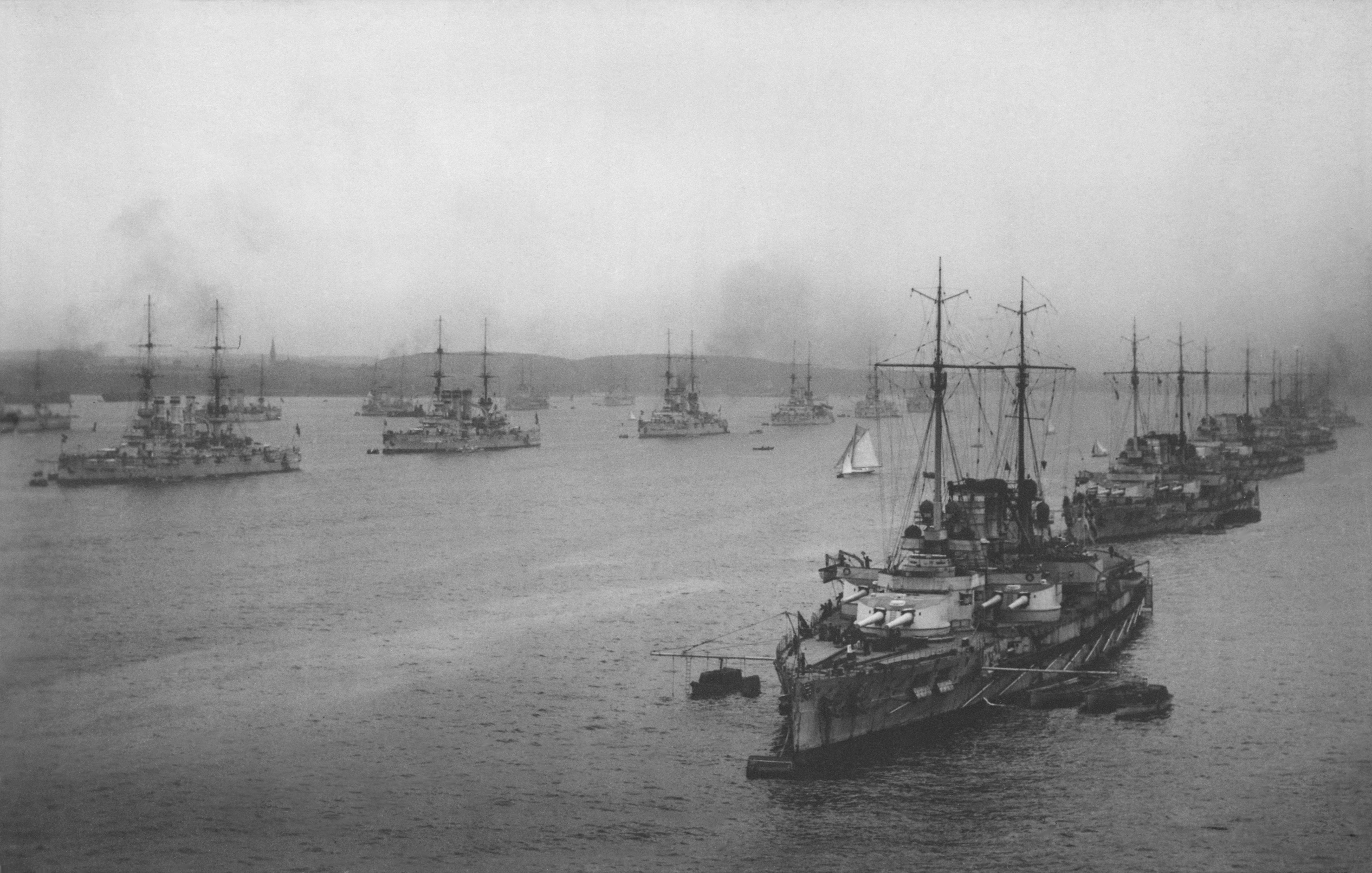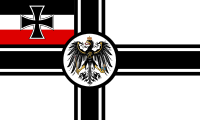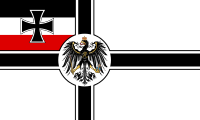
Imperial German Navy
The Imperial German Navy or the Kaiserliche Marine (Imperial Navy) was the navy of the German Empire, which existed between 1871 and 1919. It grew out of the small Prussian Navy (from 1867 the North German Federal Navy), which was mainly for coast defence. Kaiser Wilhelm II greatly expanded the navy. The key leader was Admiral Alfred von Tirpitz, who greatly expanded the size and quality of the navy, while adopting the sea power theories of American strategist Alfred Thayer Mahan. The result was a naval arms race with Britain, as the German navy grew to become one of the greatest maritime forces in the world, second only to the Royal Navy.
Imperial Navy
Kaiserliche Marine
1871–1918
Black, white and red
"Gruß an Kiel"
Imperial Admiralty (1872–1889)
High Command (1889–1899)
Imperial Naval Office (1889–1918)
Imperial Naval Cabinet (1889–1918)
Imperial Admiralty Staff (1899–1918)
The German surface navy proved ineffective during the First World War; its only major engagement, the Battle of Jutland, was a draw, but it kept the surface fleet largely in port for the rest of the war.[1] The submarine fleet was greatly expanded and threatened the British supply system during the U-boat campaign. As part of the Armistice, the Imperial Navy's main ships were ordered to be turned over to the Allies but they were instead scuttled by their own crews. All ships of the Imperial Navy bore the title SMS, for Seiner Majestät Schiff (His Majesty's Ship).
Achievements[edit]
The Imperial Navy achieved some important operational feats. At the Battle of Coronel, it inflicted the first major defeat on the Royal Navy in over one hundred years, although the German squadron of ships was subsequently defeated at the Battle of the Falkland Islands, only one ship escaping destruction. The Navy also emerged from the fleet action of the Battle of Jutland having destroyed more ships than it lost, although the strategic value of both of these encounters was minimal.
The Imperial Navy was the first to operate submarines successfully on a large scale in wartime, with 375 submarines commissioned by the end of the First World War, and it also operated zeppelins. Although it was never able to match the number of ships of the Royal Navy, it had technological advantages, such as better shells and propellant for much of the Great War, meaning that it never lost a ship to a catastrophic magazine explosion from an above-water attack, although the elderly pre-dreadnought SMS Pommern sank rapidly at Jutland after a magazine explosion was caused by an underwater attack.
Marines[edit]
The Marines were referred to as Seebataillone (sea battalions). They served in the Prussian Navy, the North German Federal Navy, the Imperial German Navy and in the modern German Navy.
The Marine-Fliegerabteilung consisted of Zeppelins (airships), observation balloons and fixed-wing aircraft.
The main use of the Zeppelins was in reconnaissance over the North Sea and the Baltic, where the endurance of the craft led German warships to a number of Allied vessels. Zeppelin patrolling had priority over any other airship activity.[41] During the entire war around 1,200 scouting flights were made. During 1915 the German Navy had some 15 Zeppelins in commission and was able to have two or more patrolling continuously at any one time.[41] They kept the British ships from approaching Germany, spotted when and where the British were laying sea-mines, and later aided in the destruction of those mines.[41] Zeppelins would sometimes land on the sea surface next to a minesweeper, bring aboard an officer and show him the lay of the mines.[41] The Naval and Army Air Services also directed a number of strategic raids against Britain, leading the way in bombing techniques and also forcing the British to bolster their anti-aircraft defences. The possibility of airship raids were approved by the Kaiser on 9 January 1915, although he excluded London as a target and further demanded that no attacks be made on historic or government buildings or museums. The night-time raids were intended to target only military sites on the east coast and around the Thames estuary, but difficulties in navigation and the height from which the bombs were dropped made accurate bombing impossible, and most bombs fell on civilian targets or open countryside.
Stationed in North Sea coastal airfields, German naval aircraft often fought against their British counterparts of the Royal Naval Air Service.[42] Naval pilots flew aircraft that were also used by the German Army's Luftstreitkräfte in addition to seaplanes. Theo Osterkamp was one of the original naval pilots, the first German pilot to fly a land-based aircraft to England on a reconnaissance mission, and its leading ace with 32 victories.[43] By war's end, the roster of German naval flying aces also included Gotthard Sachsenberg (31 victories),[44] Alexander Zenzes (18 victories),[45] Friedrich Christiansen (13 victories),[46] Karl Meyer (8 victories),[47] Karl Scharon (8 victories),[48] and Hans Goerth (7 victories).[49] Another decorated aviator was Gunther Plüschow who shot down a Japanese plane during the Siege of Tsingtao and was the only German combatant to escape from a prison camp in Britain.[50][51]
List of aircraft that were assigned to naval air service:
Naval Air Service Units included:
Marine Jagdgruppe Flandern composed of:
Post-war[edit]
After the end of World War I, the bulk of the navy's modern ships (74 in all) were interned at Scapa Flow (November 1918), where the entire fleet (with a few exceptions) was scuttled by its crews on 21 June 1919 on orders from its commander, Rear Admiral Ludwig von Reuter.[52]
Ernest Cox subsequently salvaged many of the Scapa Flow ships.
The surviving ships of the Imperial Navy became the basis for the Reichsmarine of the Weimar Republic.
The Imperial German Navy was implicated in several war crimes committed during the First World War, most notably:



